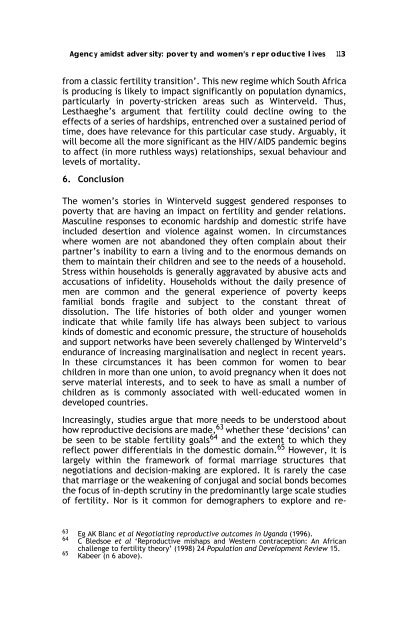Sex, Gender, Becoming - PULP
Sex, Gender, Becoming - PULP
Sex, Gender, Becoming - PULP
You also want an ePaper? Increase the reach of your titles
YUMPU automatically turns print PDFs into web optimized ePapers that Google loves.
Agency amidst adversity: poverty and women’s reproductive lives 113<br />
from a classic fertility transition’. This new regime which South Africa<br />
is producing is likely to impact significantly on population dynamics,<br />
particularly in poverty-stricken areas such as Winterveld. Thus,<br />
Lesthaeghe’s argument that fertility could decline owing to the<br />
effects of a series of hardships, entrenched over a sustained period of<br />
time, does have relevance for this particular case study. Arguably, it<br />
will become all the more significant as the HIV/AIDS pandemic begins<br />
to affect (in more ruthless ways) relationships, sexual behaviour and<br />
levels of mortality.<br />
6. Conclusion<br />
The women’s stories in Winterveld suggest gendered responses to<br />
poverty that are having an impact on fertility and gender relations.<br />
Masculine responses to economic hardship and domestic strife have<br />
included desertion and violence against women. In circumstances<br />
where women are not abandoned they often complain about their<br />
partner’s inability to earn a living and to the enormous demands on<br />
them to maintain their children and see to the needs of a household.<br />
Stress within households is generally aggravated by abusive acts and<br />
accusations of infidelity. Households without the daily presence of<br />
men are common and the general experience of poverty keeps<br />
familial bonds fragile and subject to the constant threat of<br />
dissolution. The life histories of both older and younger women<br />
indicate that while family life has always been subject to various<br />
kinds of domestic and economic pressure, the structure of households<br />
and support networks have been severely challenged by Winterveld’s<br />
endurance of increasing marginalisation and neglect in recent years.<br />
In these circumstances it has been common for women to bear<br />
children in more than one union, to avoid pregnancy when it does not<br />
serve material interests, and to seek to have as small a number of<br />
children as is commonly associated with well-educated women in<br />
developed countries.<br />
Increasingly, studies argue that more needs to be understood about<br />
how reproductive decisions are made, 63 whether these ‘decisions’ can<br />
be seen to be stable fertility goals 64 and the extent to which they<br />
reflect power differentials in the domestic domain. 65 However, it is<br />
largely within the framework of formal marriage structures that<br />
negotiations and decision-making are explored. It is rarely the case<br />
that marriage or the weakening of conjugal and social bonds becomes<br />
the focus of in-depth scrutiny in the predominantly large scale studies<br />
of fertility. Nor is it common for demographers to explore and re-<br />
63 Eg AK Blanc et al Negotiating reproductive outcomes in Uganda (1996).<br />
64 C Bledsoe et al ‘Reproductive mishaps and Western contraception: An African<br />
challenge to fertility theory’ (1998) 24 Population and Development Review 15.<br />
65 Kabeer (n 6 above).
















